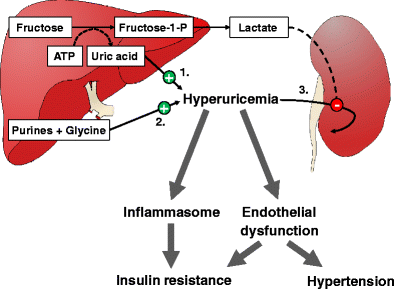Non alcoholic fatty liver disease (NAFLD) is today the most common cause of chronic liver disease, causing steatohepatitis, cirrhosis, hepatic failure and hepatocellular carcinoma. Newer insights into the issue have revealed a simple truth that it’s the sugars, fruits and grains that are the source of every alcoholic beverage and the actions and metabolism of these sugars, particularly of fructose, have several similarities with those of alcohol. Therefore, prevention and management of NAFLD have got lot to do with restriction of these dietary factors.


The Toxic Truth: Too much fructose can damage your liver, just like too much alcohol [See]
Sugar is Toxic: The growing scientific evidence, both epidemiological and mechanistic, very clearly shows that excess sugar induces all of the diseases associated with the metabolic syndrome, Robert H. Lustig et al write in Nature. See Lustig RH, Schmidt LA, Brindis CD. Public health: The toxic truth about sugar. Nature. 02 February 2012;482:27–29. doi:10.1038/482027a[Link][Report | Report | Report | Report]
Lim J, Mietus-Snyder M, Valente A et al. The role of fructose in the pathogenesis of NAFLD and the metabolic syndrome. Nat Rev Gastroenterol Hepatol 2010;7:251–264. https://doi.org/10.1038/nrgastro.2010.41
Jegatheesan P, Bandt J-PD. Fructose and NAFLD: The Multifaceted Aspects of Fructose Metabolism. Nutrients 2017;9(3):230. https://doi.org/10.3390/nu9030230. Available at https://www.mdpi.com/2072-6643/9/3/230/htm
Zhang D-M, Jiao R-Q, Kong LD. High Dietary Fructose: Direct or Indirect Dangerous Factors Disturbing Tissue and Organ Functions. Nutrients 2017;9(4):335. https://doi.org/10.3390/nu9040335 Available at https://www.mdpi.com/2072-6643/9/4/335/htm
Vos MB, Lavine JE. Dietary fructose in nonalcoholic fatty liver disease. Hepatology. June 2013;57(6):2525-2531. https://doi.org/10.1002/hep.26299. Available at https://aasldpubs.onlinelibrary.wiley.com/doi/full/10.1002/hep.26299
Duarte S, Stefano JT, Vanni D, Carrilho F, Oliveira C. Impact of current diet at the risk of non-alcoholic fatty liver disease (NAFLD). Arquivos de Gastroenterologia. 2019;56. DO – 10.1590/s0004-2803.201900000-67. Available at https://www.researchgate.net/publication/337087437_Impact_of_current_diet_at_the_risk_of_non-alcoholic_fatty_liver_disease_NAFLD/fulltext/5dc9088f299bf1a47b2cc3ed/Impact-of-current-diet-at-the-risk-of-non-alcoholic-fatty-liver-disease-NAFLD.pdf
Prussick RB, Miele L. Nonalcoholic fatty liver disease in patients with psoriasis: a consequence of systemic inflammatory burden? Br J Dermat. July 2018;179(1):16-29. https://doi.org/10.1111/bjd.16239. Available at https://onlinelibrary.wiley.com/doi/full/10.1111/bjd.16239
Gastaldelli A, Cusi K. From NASH to diabetes and from diabetes to NASH: Mechanisms and treatment options. JHEP Reports. October 2019;1(4):312-328. Available at https://www.sciencedirect.com/science/article/pii/S2589555919300795
Aron-Wisnewsky J, Gaborit B, Dutour A, Clement K. Gut microbiota and non-alcoholic fatty liver disease: new insights. Clinical Microbiology and Infection. 2013;19(4):338-348. https://doi.org/10.1111/1469-0691.12140. Available at https://www.sciencedirect.com/science/article/pii/S1198743X14609800
Mann JP et al. Nonalcoholic Fatty Liver Disease in Children. Semin Liver Dis 2018;38:1–13. Available at https://air.unimi.it/retrieve/handle/2434/606450/1395045/s-0038-1627456.pdf
Duwaerts CC, Maher JJ. Macronutrients and the Adipose-Liver Axis in Obesity and Fatty Liver. Cellular and Molecular Gastroenterology and Hepatology2019;7(4):749-761. Available at https://www.cmghjournal.org/article/S2352-345X(19)30009-8/fulltext
Taskinen M-R, Packard CJ, Borén J. Dietary Fructose and the Metabolic Syndrome. Nutrients 2019;11(9):1987. https://doi.org/10.3390/nu11091987. Available at https://www.mdpi.com/2072-6643/11/9/1987/htm
Akhtar DH, Iqbal U, Vazquez-Montesino LM, Dennis BB, Ahmed A. Pathogenesis of Insulin Resistance and Atherogenic Dyslipidemia in Nonalcoholic Fatty Liver Disease. J Clin Transl Hepatol. 2019;7(4):362. doi: 10.14218/JCTH.2019.00028. Available at https://www.xiahepublishing.com/2310-8819/ArticleFullText.aspx?sid=2&id=10.14218%2FJCTH.2019.00028
Chen Q, Wang T, Li J et al. Effects of Natural Products on Fructose-Induced Nonalcoholic Fatty Liver Disease (NAFLD). Nutrients 2017;9:96.Available at https://www.mdpi.com/2072-6643/9/2/96
Godoy-Matos AF, Silva Júnior WS, Valerio CM. NAFLD as a continuum: from obesity to metabolic syndrome and diabetes. Diabetol Metab Syndr 2020;12:60. https://doi.org/10.1186/s13098-020-00570-y. Available at https://dmsjournal.biomedcentral.com/articles/10.1186/s13098-020-00570-y
El-Agroudy NN et al. Are Lifestyle Therapies Effective for NAFLD Treatment? Trends in Endocrinology & Metabolism 2019;30(10):701-709. Available at https://www.cell.com/trends/endocrinology-metabolism/fulltext/S1043-2760(19)30136-5
Lambertz J, Weiskirchen S, Landert S, Weiskirchen R. Fructose: A Dietary Sugar in Crosstalk with Microbiota Contributing to the Development and Progression of Non-Alcoholic Liver Disease. Front. Immunol., 19 September 2017. https://doi.org/10.3389/fimmu.2017.01159. Available at https://www.frontiersin.org/articles/10.3389/fimmu.2017.01159/full


